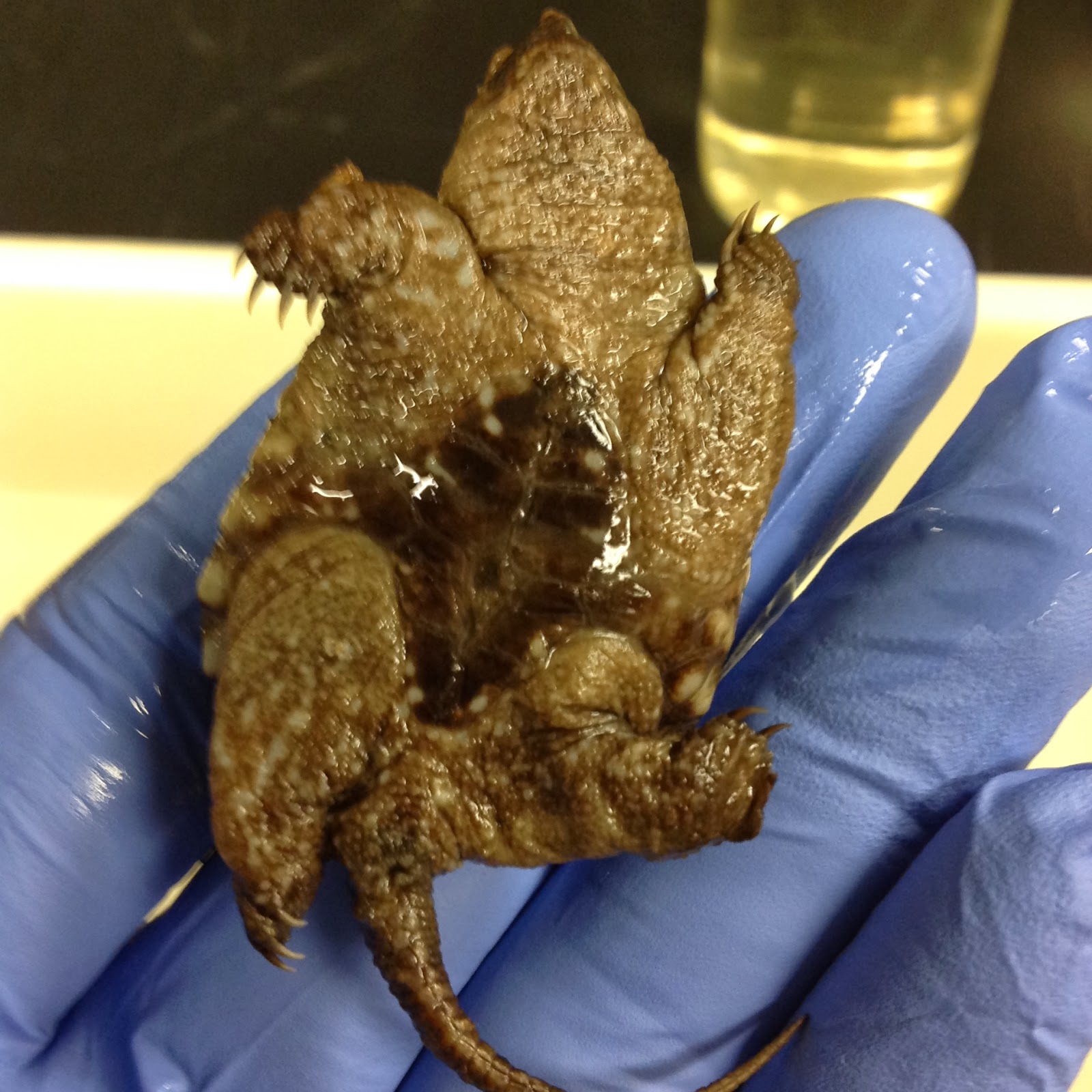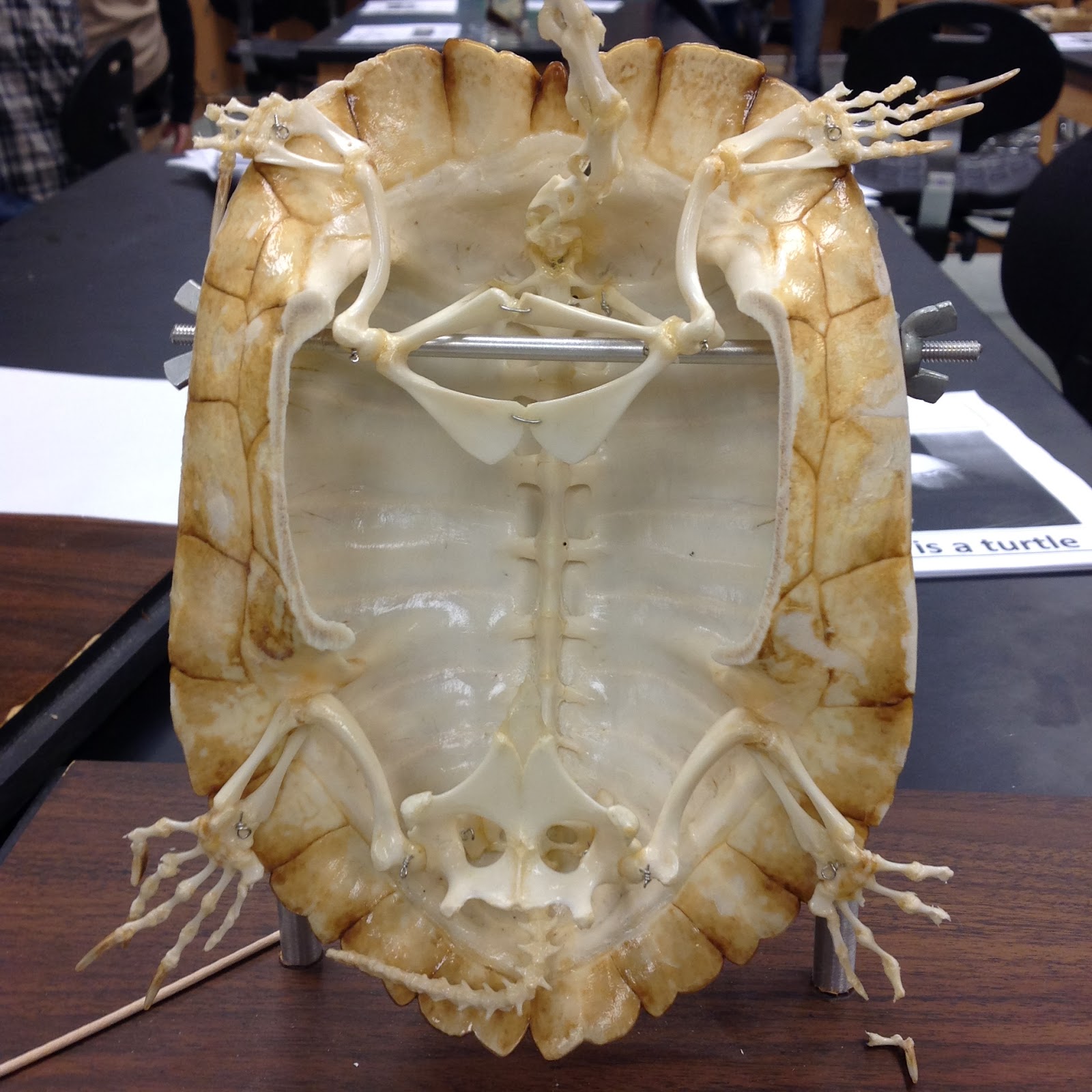Biology of the Reptilia
By: Megan Landon, Cameron Eddy, and Vince Ziccardi
Laboratory #2: Testudines
Key Points Covered in
Lab:
1. Turtle
Anatomy of the skeleton
3. Turtle
Diversity
Let’s Get a Quick Glimpse on Testudines!
·
There are 327 species of turtles categorized
into 14 Families
·
Turtle distribution is everywhere worldwide
except for Antarctica
·
Can live in habitats of marine, terrestrial, and
freshwater
·
Special morphology of the carapace and plastron
(will be discussed later)
·
Turtles lay eggs and are therefore oviparous
·
Mothers typically bury their eggs into a nest
and never return to it!
·
Extant turtles lack teeth but have keratinized
beak
·
Skull is anapsid (no temporal fenestra)
· Testudines emerged in Triassic period (210-220 mya)
· Testudines emerged in Triassic period (210-220 mya)
Extinct Ancestors of Modern Turtles:

1. Proganochelys quenstedti: note that they possessed teeth, carapace, plastron, long tail with turtles and limbs held inside the ribcage

The Turtle Skeleton: Unlike
most reptiles, the turtle skeleton is very unique due to its two parts: the carapace and plastron!
Carapace and Plastron Bones
i.
Formed by fused ribs (costal bones) and
vertebrae in trunk region (neural bones)
ii.
Note the outermost bones (peripheral bones), the
base of the spine (sacral bone), the posterior end (pygal), the anterior end
near the neck (nuchal bone), and the suprapygal bone which is between the
sacral and pygal bones
 |
| Bones of the carapace: A) Nuchal B) Neural C) Costal D) Sacral E) Suprapygal F) Pygal G) Peripheral |
b.
Plastron Bones
i.
Most anterior lateral pair of bones
(epiplastron), posterior lateral pair of bones (xiphiplastron), the median
plate on anterior side (entoplastron)
ii.
Note how the hyoplastron is above the
hypoplastron with the mesoplastron in-between the two lateral pairs of bones
Carapace
and Plastron Scutes
i.
Note that the vertebral scutes cover the spinal
region, the pleural scutes cover the ribs, and the marginal are the outermost
scutes
ii.
Also note how the supramarginal scutes fall
in-between the marginal and pleural; the cervical scute covering the neck
region of the turtle
 |
| Scutes of the carapace: A) Vertebral B) Pleural C) Marginal D) Cervical |
 |
| Supramarginal scutes present on carapace of Macrochelys temminkii, but not Chelydra serpentina |
b.
Plastron Scutes
i.
Note the intergular scutes covering the throat
of the turtle (anterior) and the anal scutes (posterior); the gular scutes are
first lateral pair followed by the humeral scutes which are underneath
ii.
The pectoral scutes are laterally paired near
the pectoral girdle (note how the axillary scutes cover the pectoral girdle),
the abdominal scutes cover the abdomen (inframarginal scutes are outside
abdominal scutes), and the femoral scutes covering the femur of the turtle
 |
| Plastron scutes: A) Gular B) Humeral C) Pectoral D) Abdominal E) Femoral F) Anal G) Inframarinal H) Axillary |
***A note on Carapace/Plastron Scutes vs. Carapace/Plastron
Bones
Vs.
(The scutes covering the bones and both the
carapace and plastron do not directly align with each other.)
Girdles
of Turtles
a.
Pectoral Girdle
i.
contains two parts of the scapula and a coracoid
b.
Pelvic Girdle
i.
the ilium (sticking out in the back), the ischium (the two
posterior bones on pelvic girdle), and the pubis (the two anteiror bones of the
pelvic girdle)
Here’s a different look by showing the entire skeleton of
the turtle. Try to see if you can identify the bones associated with the pectoral and pelvic girdles.
Turtle
Skulls
a.
Note the prefrontal, frontal, parietal, and
postorbital bones on the dorsal view of the turtle skull
b. On the ventral view, note the premaxilla,
maxilla, pterygoid, palatine, vomer (separating the right and left nasal
cavities), supraoccipital, basioccipital and exoccipital
c.
On the lateral view of the turtle, note the
jugal, quadratojugal, quadrate
Reproduction
Both sexes of turtle have anatomical characteristics, unique from both each other and from other reptiles, that allow scientists to differentiate between sexes as well as aid in the act of reproduction. In determining the sex of the turtle, the easiest way is to look at the tails. Males have a larger, fatter, overall more robust tail than females who have shorter less robust tails.
When these tails are laid straight, the cloaca of the male turtle can be found well beyond the posterior margin of the carrapace whereas the cloaca of the female is found before/ as the posterior margin of the carrapace(Fig. X).
The unique reproductive characteristics of turtles are found mainly in males. Males have a concave plastron to keep them from sliding off the female during copulation, they have longer forelimb claws which are used during courtship to "tickle" the face of the female
and they have a intromittent organ, a large appendage similar to a penis that functions to transfer sperm.
Turtles are typical amniotes and oviparous wherein they have internal fertilization resulting in a cleidoic egg laid outside the body. These cleidoic eggs have hard calcium carbonate shells to protect the embryo inside from the outer environment while also allowing gas exchange. The embryos inside the egg have direct development, meaning that when the babies hatch, they will be minature versions of their parents. (Check last week's lab for images)
Diversity
About 200 to 250 million years ago, the order Testudines split between two groups: Cryptodira and Pleurodira. Turtles that belong to Cryptodira are more commonly known as "hidden neck turtles" meaning they pull their heads straight back into their shells when frightened.
Turtles that belong to Pleurodira are more commonly known as "side-neck turtles", so when they are frightened they pull their head to the side under the edge of their shells.
Ohio Diversity
Out of the multiple families and species of turtle that are found worldwide, Ohio is home to only 4 families and 12 species.
Chelydridae - Chelydra serpentina (Common Snapping Turtle)
Kinosternidae - Sternotherus odoratus (Stinkpot Turtle)
Trionychidae -
Apalone spinifera (Spiny Softshell Turtle)
Apalone mutica (Smooth Softshell Turtle)
Emydidae - Chrysemys picta marginata (Midland Painted Turtle)
Clemmys guttata (Spotted Turtle)
Emydoidea blandingii (Blanding's Turtle)
Graptemys geographica (Map Turtle)
Graptemys pseudogeographica (False Map Turtle)
Pseudemys concinna (Hieroglyphica River Cooter)
Terrapene carolina (Eastern Box Turtle)
Trachemys scripta (Red-Eared Slider)
Both sexes of turtle have anatomical characteristics, unique from both each other and from other reptiles, that allow scientists to differentiate between sexes as well as aid in the act of reproduction. In determining the sex of the turtle, the easiest way is to look at the tails. Males have a larger, fatter, overall more robust tail than females who have shorter less robust tails.
 |
| Comparing the tail sizes of female (left) and male (right) turtles |
 |
| Ventral view of the male plastron and female plastron |
 |
| Posterior view of the male (right) and female (left) plastron |
 |
| Images comparing forearm claws (left) and cloaca position (right) of both male and female turtles |
and they have a intromittent organ, a large appendage similar to a penis that functions to transfer sperm.
 |
| Copulatory organ in male turtles |
Diversity
About 200 to 250 million years ago, the order Testudines split between two groups: Cryptodira and Pleurodira. Turtles that belong to Cryptodira are more commonly known as "hidden neck turtles" meaning they pull their heads straight back into their shells when frightened.
Turtles that belong to Pleurodira are more commonly known as "side-neck turtles", so when they are frightened they pull their head to the side under the edge of their shells.
 |
| Cryptodira |
 |
| Pleurodira |
Ohio Diversity
Out of the multiple families and species of turtle that are found worldwide, Ohio is home to only 4 families and 12 species.
Chelydridae - Chelydra serpentina (Common Snapping Turtle)
 |
| Macrochelys temminkii (top) and Chelydra serpentina (bottom) |
Kinosternidae - Sternotherus odoratus (Stinkpot Turtle)
Trionychidae -
Apalone spinifera (Spiny Softshell Turtle)
Apalone mutica (Smooth Softshell Turtle)
Emydidae - Chrysemys picta marginata (Midland Painted Turtle)
Clemmys guttata (Spotted Turtle)
Emydoidea blandingii (Blanding's Turtle)
Graptemys geographica (Map Turtle)
Graptemys pseudogeographica (False Map Turtle)
Pseudemys concinna (Hieroglyphica River Cooter)
Terrapene carolina (Eastern Box Turtle)
Trachemys scripta (Red-Eared Slider)































































